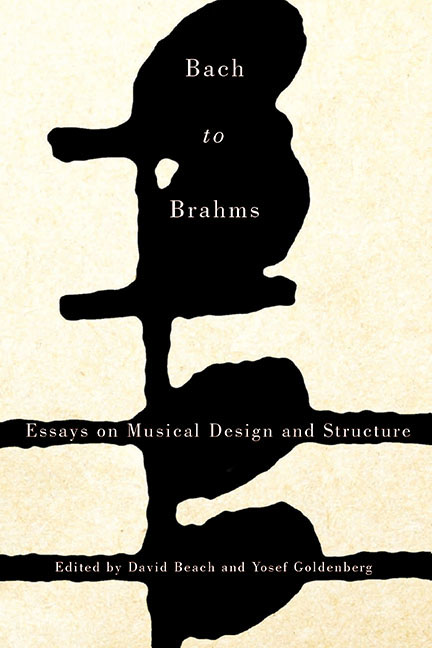Book contents
- Frontmatter
- Dedication
- Contents
- Introduction
- Part One Structure and Design
- Part Two Focus on Motive
- Part Three Structure and Design II
- 11 The “Pseudo-Einsatz” in Two Handel Fugues: Heinrich Schenker's Analytical Work with Reinhard Oppel
- 12 Formal Fusion and Its Effect on Voice-Leading Structure: The First Movement of Beethoven's Opus 132 Revisited
- 13 Indistinct Formal Functions and Conflicting Temporal Processes in the Second Movement of Brahms's Third Symphony
- 14 The Interaction of Structure and Design in the Opening Movements of Schubert's Piano Trios in B-flat Major (D. 898) and E-flat Major (D. 929)
- 15 The Suspenseful Structure of Brahms's C-Major Capriccio, Op. 76, No. 8: A Schenkerian Hearing
- List of Contributors
- Index
11 - The “Pseudo-Einsatz” in Two Handel Fugues: Heinrich Schenker's Analytical Work with Reinhard Oppel
from Part Three - Structure and Design II
Published online by Cambridge University Press: 14 March 2018
- Frontmatter
- Dedication
- Contents
- Introduction
- Part One Structure and Design
- Part Two Focus on Motive
- Part Three Structure and Design II
- 11 The “Pseudo-Einsatz” in Two Handel Fugues: Heinrich Schenker's Analytical Work with Reinhard Oppel
- 12 Formal Fusion and Its Effect on Voice-Leading Structure: The First Movement of Beethoven's Opus 132 Revisited
- 13 Indistinct Formal Functions and Conflicting Temporal Processes in the Second Movement of Brahms's Third Symphony
- 14 The Interaction of Structure and Design in the Opening Movements of Schubert's Piano Trios in B-flat Major (D. 898) and E-flat Major (D. 929)
- 15 The Suspenseful Structure of Brahms's C-Major Capriccio, Op. 76, No. 8: A Schenkerian Hearing
- List of Contributors
- Index
Summary
Heinrich Schenker corresponded regularly with Reinhard Oppel (1878–1941), professor of music theory at the Leipzig Conservatory, about the music of Handel. They corresponded intensively in 1929/30 regarding the realization of Handel's Italian cantatas, and in 1932 about the genesis of Handel's keyboard fugues in pieces by Corelli and earlier works of Handel himself. During his summer holiday from August 7–13, 1931, Oppel traveled to Vienna to consult Schenker about various analytical and compositional problems. Figuring large in the discussion was Handel's keyboard music, especially Suite no. 2 in F Major (HWV 427) and Suite no. 8 in F Minor (HWV 433). This article will focus on the fugues from these two suites.
A central analytical problem in all Baroque pieces—whether fugues or not—is the interpretation of the tonic reprise. Specifically, in these fugues, does the return of subject and answer in the tonic—parallel to their presentation in the exposition—represent a structural return to tonic harmony, or is this tonic return subsumed within a through-composed harmonic progression? In the latter case, the definitive tonic return would be achieved only with the final chord. Let us consider this question in relation to our two fugues.
In the Fugue in F Major, Handel brings back the opening subject in the tonic in the upper voice in measure 35, and the answer follows in the bass in measure 37. Does the return of the subject in measure 35 as heard in the fugal exposition represent a return to tonic harmony, which has been prolonged from the outset? Analogously, in the Fugue in F Minor, Handel returns to the opening subject—the rising fifth F–C—emphatically in measure 109, and the answer in 128. Again, does the return to F minor in measure 109 signify a structural return to the tonic?
Schenker's lesson boo ks disclose that he began analyzing Handel's Second Suite in F Major in October 1928 with Anthony van Hoboken, but he worked most intensively on it with Angelika Elias over the course of one year, from January 1929 to January 1930.
- Type
- Chapter
- Information
- Bach to BrahmsEssays on Musical Design and Structure, pp. 173 - 203Publisher: Boydell & BrewerPrint publication year: 2015



